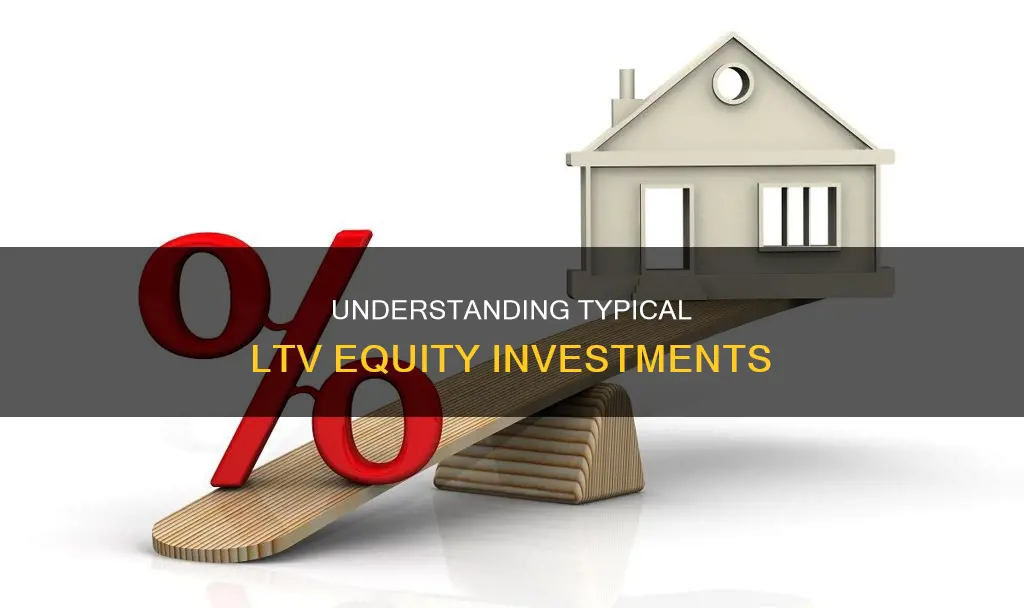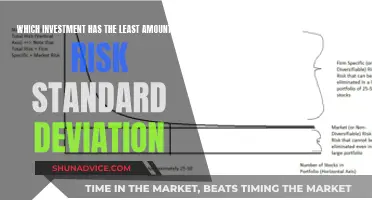
The loan-to-value (LTV) ratio is a metric used by lenders and investors to assess the risk associated with a loan. It is calculated by dividing the loan amount by the appraised value of the underlying asset, typically expressed as a percentage. For example, if an individual borrows $80,000 to purchase a $100,000 property, the LTV ratio is 80%. A higher LTV ratio indicates a riskier loan, as the borrower has less equity in the asset, increasing the likelihood of default. This results in higher interest rates and more stringent loan conditions. Conversely, a lower LTV ratio is favourable as it signifies a lower risk to lenders, potentially leading to better loan terms and interest rates. Lenders typically consider an LTV ratio of 80% or lower as a threshold for safer loans.
| Characteristics | Values |
|---|---|
| Purpose | Assess the risk of a loan |
| Calculation | Loan Amount / Appraised Value of Property x 100 |
| Lenders' Perspective | Higher LTV = Higher Risk |
| Borrowers' Perspective | Lower LTV = More Attractive Loan Terms |
| Typical LTV Threshold | 80% |
What You'll Learn

Lenders use the LTV ratio to determine the risk of a loan
Lenders use the loan-to-value (LTV) ratio to determine how much risk they are taking on when considering a loan for approval. The LTV ratio is calculated by dividing the loan amount by the value of the asset being purchased, then multiplying by 100 to get a percentage. This metric is used by lenders to compare the value of a loan against the market value of the asset that secures it.
A high LTV ratio indicates that a loan is riskier for the lender. This is because there is a greater chance of the loan going into default, as there is very little equity built up within the property. In the event of a foreclosure, the lender may struggle to sell the property for enough to cover the outstanding mortgage balance. As a result, lenders will often charge higher interest rates on loans with higher LTVs, to mitigate their risk.
A lower LTV ratio is generally preferable, as it indicates lower risk. Lenders will often offer lower interest rates for these loans, as well as not requiring the borrower to take out mortgage insurance.
The LTV ratio is just one factor in determining eligibility for a loan, but it can play a substantial role in the interest rate that a borrower is able to secure.
Impact Investing: Private Equity's Power and Potential
You may want to see also

A higher LTV ratio means higher interest rates
The loan-to-value (LTV) ratio is a financial term used by lenders to assess the risk of lending to a borrower. It is calculated by dividing the loan amount by the appraised value of the asset, then multiplying by 100 to get a percentage. A higher LTV ratio indicates a riskier loan for the lender, as it means that the borrower has less equity in the asset. As a result, loans with higher LTV ratios often come with higher interest rates to compensate for the increased risk.
In the context of mortgage lending, a higher LTV ratio means the borrower is taking out a larger loan relative to the value of the property. Lenders perceive these loans as higher risk because there is a greater chance of the loan going into default, as there is very little equity built up in the property. As a result, lenders will often charge a higher interest rate on mortgages with higher LTV ratios to offset the increased risk.
Additionally, borrowers with higher LTV ratios may be required to purchase private mortgage insurance (PMI) to protect the lender in case of default. This adds to the overall cost of the loan. Most lenders offer the lowest interest rates on mortgages with an LTV ratio of 80% or below, while loans with LTV ratios above 80% typically come with higher interest rates and may require PMI.
The LTV ratio is an important factor in the lending process, but it is not the only consideration. Lenders also look at factors such as the borrower's income, credit score, and debt-to-income ratio when evaluating a loan application. However, a higher LTV ratio generally indicates a higher level of risk for the lender and, therefore, a higher interest rate for the borrower.
It is worth noting that the LTV ratio is not the only factor that determines interest rates. Other factors, such as market conditions, the borrower's creditworthiness, and the specific loan program, can also influence the interest rate offered by the lender.
The Importance of Maintaining Your Investment Portfolio
You may want to see also

LTV is calculated by dividing the loan amount by the asset value
The loan-to-value (LTV) ratio is a metric used by lenders and financial institutions to assess the risk of lending. It is calculated by dividing the loan amount by the appraised value of the property or asset being purchased. This ratio is expressed as a percentage and is used to determine the level of risk associated with the loan. A high LTV ratio indicates a higher-risk loan, while a lower LTV ratio is considered less risky for the lender.
When it comes to mortgages, the LTV ratio plays a crucial role in the lending process. Lenders use this ratio to decide whether to approve a mortgage and to determine the interest rate offered to the borrower. Typically, a lower LTV ratio is favourable for lenders as it indicates that the borrower has more equity in the property. This reduces the likelihood of default and makes it easier for the lender to recover their investment in the event of foreclosure.
For example, let's consider an individual purchasing a home appraised at $100,000. If they make a down payment of $10,000, they will need to borrow $90,000. In this case, the LTV ratio would be 90% ($90,000/$100,000). Lenders usually offer the lowest interest rates when the LTV ratio is at or below 80%. If the LTV ratio exceeds 80%, borrowers may be required to purchase private mortgage insurance (PMI) to offset the higher risk for the lender.
The LTV ratio is not just relevant for mortgages but also applies to other types of loans, such as commercial real estate loans. In commercial lending, the LTV ratio is used to assess the risk associated with lending to real estate investors. A lower LTV ratio indicates that the borrower has made a larger down payment and has more equity in the property, reducing the risk for the lender.
In summary, the LTV ratio is a critical metric in lending, particularly in the context of mortgages and real estate investments. It helps lenders evaluate the risk associated with a loan and determines the interest rate and other terms offered to the borrower. By understanding the LTV ratio, borrowers can make more informed decisions about their loan options and the potential costs involved.
Investing Life Savings: Strategies for Long-Term Financial Growth
You may want to see also

A lower LTV ratio means a lower risk for lenders
The loan-to-value (LTV) ratio is a metric used by lenders and financial institutions to assess the risk of lending to a borrower. It is calculated by dividing the loan amount by the appraised value of the property, and the result is expressed as a percentage. A lower LTV ratio is generally considered to be better for lenders as it indicates a lower risk.
When a borrower applies for a loan, the lender will assess the LTV ratio to determine the level of risk associated with the loan. A lower LTV ratio means that the borrower has a higher down payment and more equity in the property. This reduces the likelihood of the loan going into default, as the borrower has more invested in the property. From the lender's perspective, this means that there is a lower risk of losing money if the borrower defaults on the loan.
Additionally, a lower LTV ratio can result in a lower interest rate for the borrower. This is because the lender perceives the loan as less risky and is therefore willing to offer a more favourable interest rate. In contrast, a higher LTV ratio may require the borrower to purchase private mortgage insurance (PMI) to offset the higher risk for the lender. This additional insurance can increase the overall cost of the loan for the borrower.
Most lenders consider an LTV ratio of 80% or lower to be ideal, as it indicates a lower risk and provides a higher chance of loan approval. An LTV ratio above 80% is typically considered a high LTV, which may lead to higher borrowing costs, the requirement for PMI, or even loan denial. Therefore, borrowers are generally advised to aim for an LTV ratio of 80% or lower to increase their chances of securing favourable loan terms.
In summary, a lower LTV ratio indicates a lower risk for lenders as it represents a higher down payment and more equity in the property. This reduces the likelihood of default and makes it easier for the lender to recoup their investment in the event of foreclosure. As a result, borrowers with lower LTV ratios may be offered lower interest rates and more favourable loan terms.
Where to Invest: India or USA?
You may want to see also

LTV is one of many tools used when evaluating a borrower's loan proposal
Lenders use the loan-to-value (LTV) ratio to assess the lending risk factor and determine whether to approve a loan request. The LTV ratio is calculated by dividing the loan amount by the appraised value of the property, expressed as a percentage. A higher LTV ratio indicates a higher-risk loan, which will cost the borrower more.
Lenders perceive that there is a greater chance of default when the loan amount is at or near the appraised value of the property, as there is very little equity built up. As a result, the interest rate on the loan is typically higher for loans with a higher LTV ratio. Most lenders offer the lowest possible interest rate when the LTV ratio is at or below 80%.
While LTV is an important metric, it is not the only factor considered by lenders when evaluating a borrower's loan proposal. Other factors include the borrower's credit score, income stability, debt-to-income ratio, and market volatility. Lenders also assess the borrower's ability to make regular mortgage payments, improve their credit score, and monitor their home value.
Additionally, in the case of real estate investing, the credibility and reputation of the investor play a role in the lender's decision-making process. A savvy commercial real estate investor with a strong market reputation may have a greater chance of securing funding even with a high LTV ratio.
Managing Risk: Investing for Retirement
You may want to see also
Frequently asked questions
LTV stands for Loan-to-Value. It is a ratio used by lenders to assess the risk of lending money, and it is calculated by dividing the loan amount by the appraised value of the property.
A high LTV means a higher risk for the lender, so they will typically charge a higher interest rate. A lower LTV indicates less risk, which can lead to a lower interest rate and better loan conditions.
A good LTV ratio is generally considered to be 80% or lower, indicating that the loan amount is 80% or less of the property's value and leaving at least 20% equity.
To improve your LTV ratio, you can make regular mortgage payments, increase your home's value through renovations or take steps to improve your credit score.







